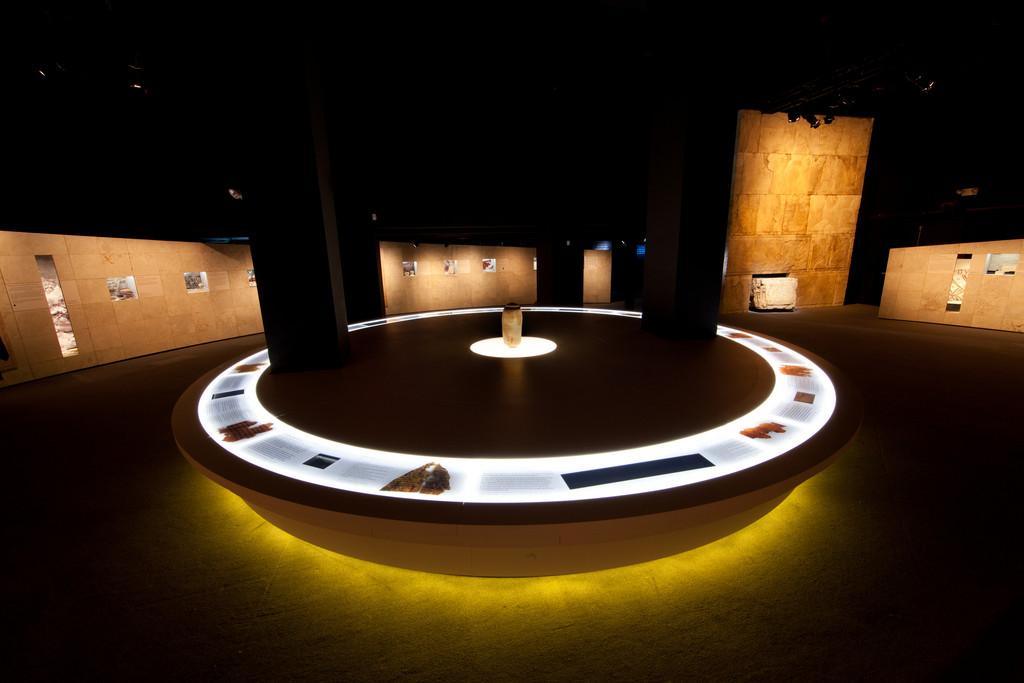Dead Sea Scrolls on display in Times Square
For the first time in their history, the priceless parchments uncovered in caves overlooking the Dead Sea, have arrived in America, making their premiere at Discovery Times Square exhibition center. “This unique new exhibit embodies the best that Discovery Times Square has to offer. Quality, historical stories that are brought to life right in front of visitors’ eyes,” said James Sanna, CEO of the center.
Billing itself as “more than a museum,” the three-year old center, located in the basement of the former New York Times headquarters combines oversize screen displays, strategically directed lighting and actors alongside the artifacts, a walk-through show intended to capture the setting of ancient Israel.
Upon descending into the basement, a dimly lit room has spotlights focusing on selected biblical quotations, opening up into a second room with six giant flat screens showing a panorama of the Dead Sea landscape. An employee dressed in the earthy uniform of an archeologist introduces the visitors to the allure of archeology in the Holy Land. The doors then open up into the self-guided exhibit, which includes the full historical spectrum of ancient Israel, from the Canaanites to the Ottoman Turks.
“The Israel Antiquities Authority sees this as an opportunity to allow the world to share in and learn from, indeed to experience, our connection with Ancient Israel, the place where much of our common heritage and civilization was formulated,” said Yeshive University undergraduate Vice-Provost Dr. Lawrence Schiffman, who was consulted on the design of the exhibit. This is the largest collection of artifacts and scrolls ever exhibited outside of Israel.”
The rare finds include coins from the Hasmonean period and domestic altars from the kingdom of Israel. An interplay between religious tenets and the influence of the surrounding idolatry is told in the square stone altars, used in ancient homes for sacrificial offerings.
While Jeroboam promoted their use in northern Israel, Hezekiah insisted on the supremacy of Jerusalem as a place of prayer and sacrifices. Like the Holy Temple altar, the domestic altars have horns on each of their corners, as prescribed in the Torah.
Descending further into a sub-basement, the fragments of the Dead Sea Scrolls are laid out on a rounded table in a rotunda, but they do not command the same amount of attention as they would in their permanent home, the Shrine of the Book in Jerusalem. Surrounding the table is a wall paneled with Jerusalem stone tiles, highlighting the lavish Temple-centered life in Jerusalem in contrast to the monastic settlement at Qumran.
Noticeably absent is any mention of modern Middle Eastern politics, with locations of the objects listed by their town or city, not mentioning whether Qumran is in Israel or the West Bank. While some mention of Christianity is given, for the most part, the exhibit, which runs until April 15, is a walk through the daily life and religious values of biblical times. One small, controversial piece is the Yeshua ben Yehoseph ossuary, a limestone box dating from the first century that contained the bones of a man who shared the same Hebrew name as Jesus, the Jewish rebel contemporary who inspired an offshoot religion.
In contrast to their permanent home, where the scrolls command undivided attention, their New York premiere bills them as the culmination of the ancient Israeli timeline, which soon after ended with the defeat at Masada. The mysterious Essene Jewish community unwittingly made a time capsule, preserving a written record of their time, buried in a cave in an uninhabitable corner of the land.
“The Dead Sea Scrolls: Life and Faith in Biblical Times” is on view through April 15 at Discovery Times Square at 226 West 44 Street in Manhattan. Hours are 10 a.m. to 7 p.m. and until 8 p.m. on weekends. Last entry is an hour prior to closing. For ticket prices and reservations, visit www.discoverytsx.com.

 61.0°,
Mostly Cloudy
61.0°,
Mostly Cloudy 




